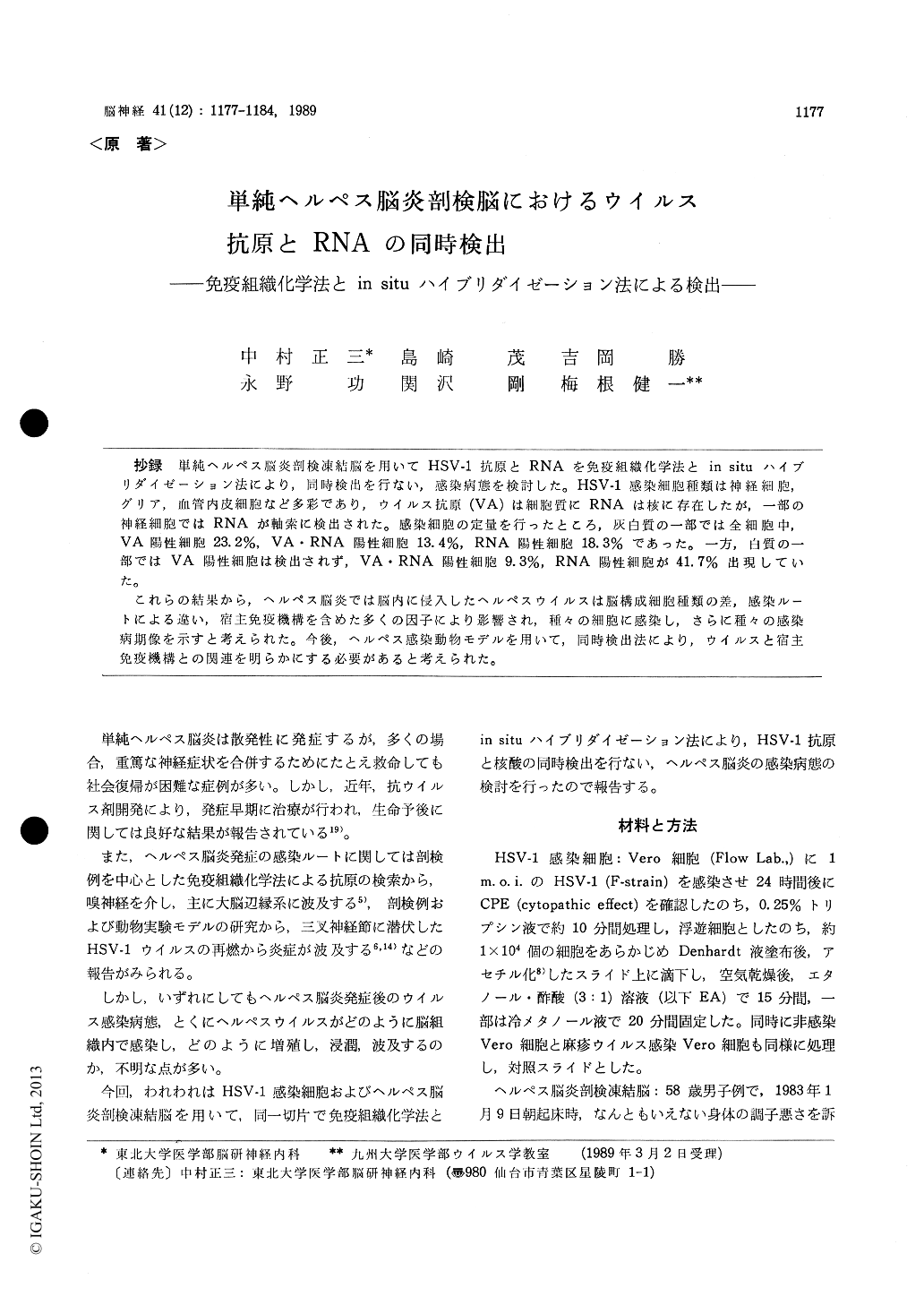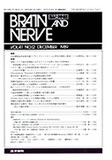Japanese
English
- 有料閲覧
- Abstract 文献概要
- 1ページ目 Look Inside
抄録 単純ヘルペス脳炎剖検凍結脳を用いてHSV−1抗原とRNAを免疫組織化学法とin situハイブリダイゼーション法により,同時検出を行ない,感染病態を検討した。HSV−1感染細胞種類は神経細胞,グリア,血管内皮細胞など多彩であり,ウイルス抗原(VA)は細胞質にRNAは核に存在したが,一部の神経細胞ではRNAが軸索に検出された。感染細胞の定量を行ったところ,灰白質の一部では全細胞中,VA陽性細胞23.2%, VA・RNA陽性細胞13.4%, RNA陽性細胞18.3%であった。一方,白質の一部ではVA陽性細胞は検出されず,VA・RNA陽性細胞9.3%,RNA陽性細胞が41.7%出現していた。
これらの結果から,ヘルペス脳炎では脳内に侵入したヘルペスウイルスは脳構成細胞種類の差,感染ルートによる違い,宿主免疫機構を含めた多くの因子により影響され,種々の細胞に感染し,さらに種々の感染病期像を示すと考えられた。今後,ヘルペス感染動物モデルを用いて,同時検出法により,ウイルスと宿主免疫機構との関連を明らかにする必要があると考えられた。
In order to elucidate the correlation between herpes simplex virus (HSV-1) and the central nervous system tissue, we performed the simul-taneous detection of viral antigens and RNA in the brain tissue sections from a patient with herpes simplex virus (HSV) encephalitis using immunocytochemistry and in situ hybridization.
In the present study the hybridization protocol reported by Brahic M et al.3) in 1984 were applied for the simultaneous detection of viral RNA and antigens with a few modification.
The sections were first immunocytochemically stained to detect HSV-1 antigens by ABC method, and then hybridized with 3H-labelled HSV-1 cDNA probe for the detection of RNA after the acetylation of slides for the prevention of non-specific bindings of isotope to slides.
In the present study, viral antigens were im-munocytochemically stained as brown-colored deposits located in the cytoplasm and nucleus whereas viral RNA were detected as the ac-cumulation of many silver grains over the nuclei or cytoplasm. In this case the light microscopic findings in a part of temporal lobe showed mul-tiple areas of necrosis mainly involving the graymatter and a few inflammatory changes such as perivascular cell cuffings.
HSV-1 infected Vero cells as positive control demonstrated both antigens and RNA as shown in Fig. 1 a. However, no hybridization signals and color deposits were observed in uninfected Vero cells.
In frozen brain tissue sections of herpes simplex encephalitis the viral antigen (VA) positive cells, containing brown-colored deposits located pri-marily in the cytoplasm, were widely distributed throughout the lesions of a part of gray matter (Fig. 2 a). Such VA positive cells were morpho-logically identified to be swollen neurons (Fig. 2 c, d), glial cells and endothelial cells. In addition, some of VA positvie cells have also hybridization signals over the nuclei, namely VA and RNA positive cells which were diffusely located close to VA positive cells (Fig. 2 d, e, f). Moreover, only RNA positive cells with numerous silver grains over the nuclei were predominantly dis-tributed at the neighborhood of VA positive cells and at the white matter (Fig. 2 b). As shown inFig. 2 d, it seems that the presence of many silver grains over the axon of a neuron indicates to transport viral RNA via axonal flow.
In quantitative analysis of HSV-1 infected cells of a part of gray matter, cells positive with VA were counted 23. 2% of total cells. Both VA and RNA positive cells and only RNA positive cells were detected 13. 4% and 18. 3% respectively. In addition, in a part of white matter VA and RNA positive cells and only RNA cells were found 9. 3% and 41. 7% although there was not detected VA positive cells (Table 1).
We concluded that the HSV infects the various kind of cells composed of brain tissues and shows the various stages of infection, namely ; VA posi-tive cells, VA and RNA positive cells and only RNA positive cells. Moreover, it may be con-sidered that these various stages of infected cells are developed according to many factors such as different kind of cells, infectious routes and host immune responses.

Copyright © 1989, Igaku-Shoin Ltd. All rights reserved.


